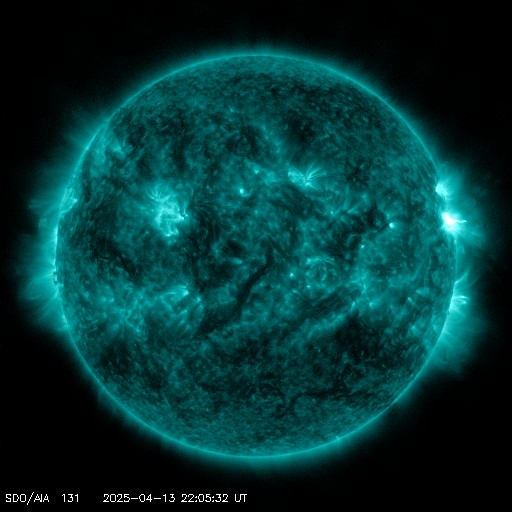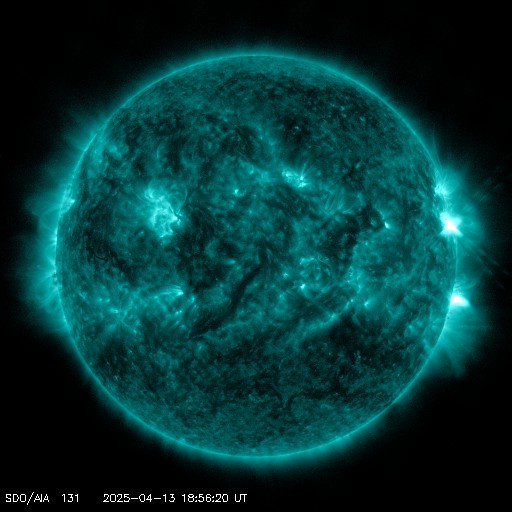Viewing archive of Friday, 5 January 2018
Daily bulletin on solar and geomagnetic activity from the SIDC
Issued: 2018 Jan 05 1342 UTC
SIDC Forecast
Solar flares
Quiet conditions (<50% probability of C-class flares)
Geomagnetism
Quiet (A<20 and K<4)
Solar protons
Quiet
| 10cm flux | Ap | |
|---|---|---|
| 05 Jan 2018 | 070 | 003 |
| 06 Jan 2018 | 071 | 004 |
| 07 Jan 2018 | 070 | 004 |
Bulletin
The solar activity was quiet over the past 24 hours and no flare has been recorded. A small sunspot has recently emerged (NOAA active region 2693) on the north-west quadrant of the visible disc. Quiet flaring conditions are expected for the next 24-hour period with possible but not very likely C-class flares from the newly emerged sunspot.
No Earth directed Coronal Mass Ejection has been observed. The greater than 10 MeV solar protons flux remained at nominal levels over the past 24 hours and is expected to remain so.
The Earth was within the slow solar wind speed regime over the past 24 hours. The solar wind speed was ranging between 350 and 400 km/s. The interplanetary magnetic field magnitude was below 5 nT, and the Bz component was ranging from -4 to 4 nT. A northern polar coronal hole extending down to latitude 20 degrees is currently facing Earth. Solar wind enhancements and high speed streams associated with the coronal hole are not expected to arrive before Jan 08.
The geomagnetic conditions were quiet and it is expected to remain quiet as the Earth is within the slow solar wind speed stream. Disturbance of the geomagnetic conditions are anticipated on Jan 08 due to the arrival of the high speed streams associated with the coronal hole.
Today's estimated international sunspot number (ISN): 011, based on 09 stations.Solar indices for 04 Jan 2018
| Wolf number Catania | /// |
| 10cm solar flux | 070 |
| AK Chambon La Forêt | 007 |
| AK Wingst | 003 |
| Estimated Ap | 003 |
| Estimated international sunspot number | 013 - Based on 15 stations |
Noticeable events summary
| Day | Begin | Max | End | Loc | Strength | OP | 10cm | Catania/NOAA | Radio burst types | |
|---|---|---|---|---|---|---|---|---|---|---|
| None | ||||||||||
Provided by the Solar Influences Data analysis Center© - SIDC - Processed by SpaceWeatherLive
All times in UTC
Current data suggests there is a slight possibility for aurora to appear at the following high latitude regions in the near future
Gillam, MB, Yellowknife, NTLatest news
Latest forum messages
Support SpaceWeatherLive.com!
A lot of people come to SpaceWeatherLive to follow the Sun's activity or if there is aurora to be seen, but with more traffic comes higher server costs. Consider a donation if you enjoy SpaceWeatherLive so we can keep the website online!

Latest alerts
04:45 UTC - Geomagnetic activity
Active geomagnetic conditions (Kp4) Threshold Reached: 04:29 UTC
Sunday, 13 April 2025
22:21 UTC - Solar flare
Moderate M1.66 flare from sunspot region 4055
22:03 UTC - Radio Blackout
Minor R1 radio blackout in progress (≥M1 - current: M1.01)
20:48 UTC - Hemispheric Power Index
The OVATION model predicts the Hemispheric Power Index to reach 50GW at 21:39 UTC
19:09 UTC - Solar flare
Moderate M3.24 flare from sunspot region 4055
Space weather facts
| Last X-flare | 2025/03/28 | X1.1 |
| Last M-flare | 2025/04/13 | M1.6 |
| Last geomagnetic storm | 2025/04/06 | Kp5 (G1) |
| Spotless days | |
|---|---|
| Last spotless day | 2022/06/08 |
| Monthly mean Sunspot Number | |
|---|---|
| March 2025 | 134.2 -20.4 |
| April 2025 | 132.1 -2.1 |
| Last 30 days | 132.4 -10.7 |





